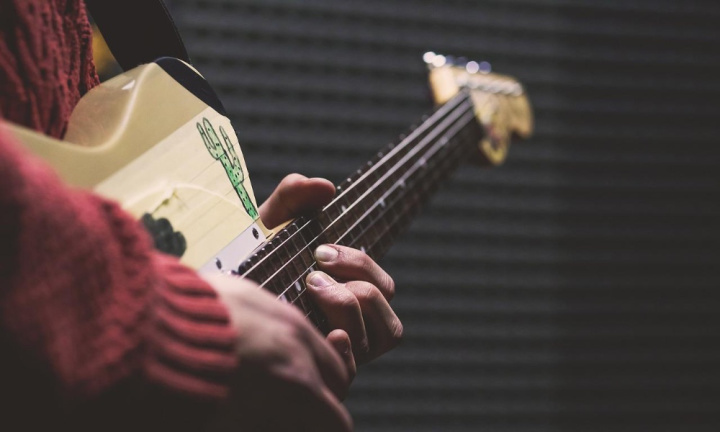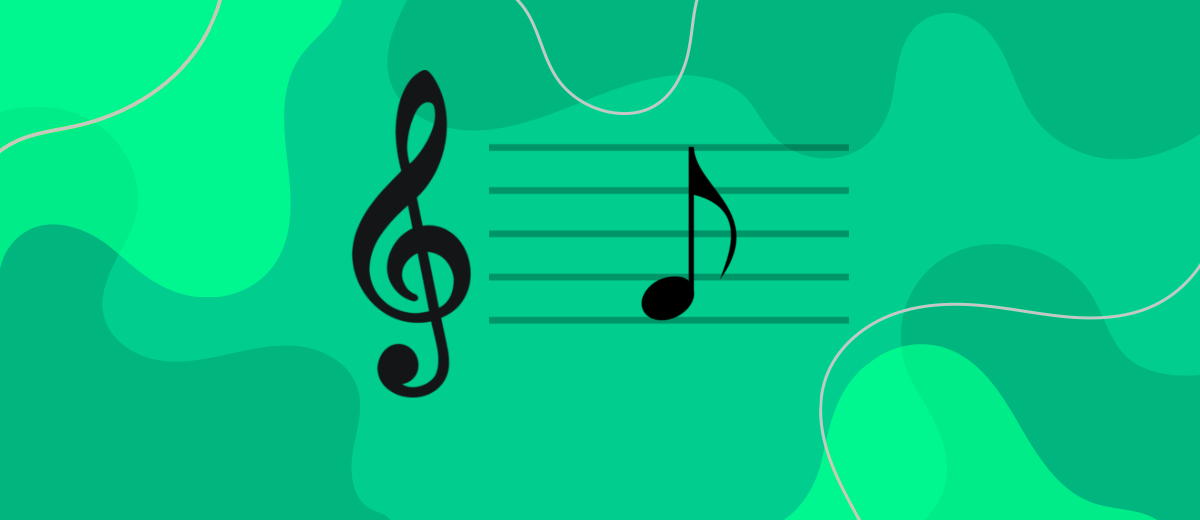How to Use Music in Business
Music accompanies us almost everywhere: in a taxi, a cafe and a restaurant, a fitness club and a beauty salon, a small shop near the house and a large supermarket. Many people think that it is included just to cheer up, but in fact this is not entirely true. It turns out that it helps to increase sales, increase the number of regular customers and buyers. From our article you will learn how the melody affects the human psyche and how audio marketing works.
Content:
1. A brief excursion into history
2. A tool to influence clients and buyers
3. Audio marketing
4. A tool to influence employees
5. Summing up
A brief excursion into history
The influence of music on the human psyche was noticed in ancient times. Then people actively used it during religious ceremonies, raised their morale in battles, and also used it as a healing agent for the treatment of diseases. The ancient Greek thinker Plato, back in the 6th century BC, said that music is the most powerful tool that simultaneously affects the soul, mind and body of a person.
The ancient Greek philosopher Pythagoras stated that music has a direct impact on health, discovered its therapeutic effect and developed a whole system of audio therapy. At his university, he began every day with singing and ended it with him. Morning melodies were supposed to help wake up and cheer up, and evening melodies, on the contrary, set them up for rest. The Thinker recommended that male representatives listen to compositions that are distinguished by high energy and rhythm, and ladies - calm motives that give peace and good mood.
A tool to influence clients and buyers
In 1986, British marketing professor Ronald Milliman conducted an interesting study. He wanted to understand how fast and slow music affects the behavior of restaurant guests. Watching them, he found out that under dynamic compositions, visitors were in the institution for about 45 minutes, and under calm and smooth ones – as much as 11 minutes longer. Interestingly, in the second case, the average check of the guest also grew - by about $30.
To conduct such an experiment, Ronald Milliman was prompted by his own observation 4 years ago. It was then that he noticed for the first time that shoppers in the supermarket to slow tunes spend more time inside the store and choosing goods, and also make more purchases. Why is this happening? It turned out that a person, without noticing it, "tunes in" to the rhythm of the music in the background and moves according to its pace – accelerating or, conversely, slowing down. Walking slowly past the showcases, you can better examine the goods. At the same time, your eye will definitely catch on those that would not hurt to purchase, despite the fact that they are not on the pre-compiled shopping list. As a result, the number and frequency of unplanned purchases increases.
It would seem that everything is simple: you need to raise profits – turn on slow music. This rule does not work everywhere. In some cases, you can get the opposite effect. Consider fast food restaurants (McDonald's, KFC) as an example. The menu there is limited to a few dishes that are familiar to many from childhood. Here, almost no one spends a lot of time choosing a hamburger or a drink. Visitors come here mainly for a quick bite or to buy food to go. Income in establishments of this format can be increased by influencing not the average check, but the increase in client flow. The main goal: it is necessary that the guest finishes his order as soon as possible, leaves and vacates the table for the next visitor. Energetic music will help to achieve it. In retail sales, dynamic background music drives revenue growth. For example, in sporting goods stores, it will create a cheerful and inspired mood in the buyer, which will lead to a feeling of a surge of energy for sports activities. The result is the purchase of any inventory, even if a person initially just went to get acquainted with the assortment.

Music still can't do that. A well-chosen audio sequence can focus the visitor's attention on a particular product. Adrian North, professor of psychology at the University of Edinburgh, conducted a personal study of consumer behavior. His results were very interesting. It turned out that the sound of French musical compositions in the store leads to an increase in sales of wine from this particular state compared to alcoholic beverages produced in other countries. Wines from France were bought more often than from Germany. This property of the musical decor of the trading floor can be exploited in other areas of trade. Let's illustrate with an example: if a travel agency seeks to sell the maximum number of tickets to the Brazilian carnival, it is advisable to include passionate Latin American motifs in the background in the office - they will help achieve the desired goal.
Audio marketing
Audio marketing is a modern trend in commerce that studies how background music can change consumer behavior. Ir is also called the gray cardinal of business. In the past few years, the activity of using audio marketing tools in business has increased significantly. Companies use specially designed programs that count the number of customers or visitors, analyze their gender and age category, and then automatically select those musical compositions that they should like.
Stock music has become an increasingly popular tool for audio marketing, especially with the growing popularity of video presentations. One of the most important features of stock music is that it can be used in a variety of ways—as background music for video projects, as a soundtrack for advertising campaigns, and even as a tool to attract new customers. Videvo has royalty-free music that can be used for any business purpose. The company offers a huge database of songs, which users can download and use at no cost.
The right melodic background will help improve the company's performance in several ways at once:
- Attraction of new clients;
- increasing sales;
- increase in the average check;
- increasing brand awareness.
According to a scientific study published on the Science Daily resource, with the help of music, you can easily guess the brand "from the first notes." For example, the well-known advertising of the Coca-Cola drink in the Christmas style firmly fixed in the minds of people the connection between this product and the pre-holiday period of waiting for the New Year or Advent (for believers). The audio logo of the Nokia brand is probably well known even to those who have never had a mobile phone of this brand. Among the most recognizable are also Intel, Apple, 20th Century Fox.
Where is used
The first to use background music in public places was the American scientist and inventor George Owen Squire, who founded Muzak Holdings. With his submission, soothing compositions began to sound in the elevators of New York skyscrapers in order to reduce the level of anxiety and fear of passengers who are afraid of confined spaces and heights.


Massive use of audio marketing tools came in the 1980s. During this period, psychologists received evidence of the direct influence of music on the behavior of buyers:
- the formation of their sympathy for the brand and devotion to it;
- increased time spent in the store;
- an incentive to make more purchases than originally planned.
Today, audio marketing is actively used by the service sector: bars, cafes and restaurants, small shops from the “two steps from home” category and large hypermarkets, hairdressers, barbershops and beauty salons, fitness clubs and even gas stations cannot do without musical decor. It sounds incredible, but with the right background music, malls and malls can really control the speed at which a shopper makes a decision. Let's consider how this correction of consciousness works. During typical low-traffic hours (such as early morning hours), the store puts on slow, calm musical compositions. Unconsciously “tuning in” with them, customers slowly walk past racks and showcases, study the packaging of goods and the contents of labels for a long time, and as a result, they buy more and increase the average check in this way. During high traffic hours, on the contrary, the store includes a dynamic musical decor. By instinctively adjusting to the tune, visitors move more energetically and decide what they need to buy more quickly.
Most often, the background music is dictated by the specifics of a particular institution. Gyms and fitness clubs tend to use energizing, uptempo tracks as they encourage patrons to push their workouts. Bars and cafeterias turn up the volume so that guests spend less time talking and more time eating and drinking. In car dealerships, audio marketing tools are usually used to broadcast advertising and informational content.

As an example of the "live" use of audio marketing, let's take the retail outlets of the Hollister clothing brand. Buyers come here not only for style and price, but also for the opportunity to feel belonging to the elite brand Abercrombie & Fitch. We should also dwell on the unique design of Hollister stores. The decor of each of them necessarily contains the motifs of a beach holiday (surfboards, palm trees, sand, and so on). In the central part there is a seating area with leather upholstered furniture. Upon crossing the threshold, the visitor immediately catches the delicate aroma of HCo SoCal branded perfume, which is sprayed by a special system. Speakers located throughout the store loudly (according to corporate rules - no less than 80-85 decibels) play compositions popular among surfers, immersing customers in the world of wave conquerors and pushing them to purchase.
To build a strong connection between a brand and its target audience on an emotional level, companies today use scientific advances in the fields of psychology and neurophysiology. They make a detailed portrait of the client, conduct a thorough analysis of his behavior and personal experience. Deeply immersed in the study of their customers, some companies apply the concept of archetypes proposed by the famous Swiss psychoanalyst Carl Gustav Jung. American researcher Carol Pearson rethought and successfully applied it to branding. Its essence boils down to the fact that all clients are conditionally divided into 12 main archetypes, each of which is suitable for a separate type of music. This concept helps companies find their customers more easily and quickly, as well as communicate productively with them.
Efficiency
Analysts of the American research company Gallup received data according to which about a third of people make a decision to purchase a product or service under the influence of audio compositions. According to the Swedish consulting company HUI Research, using music that is in line with brand values can increase sales by 9%.
The owners of the vast majority of pubs and bars (93%) believe that a good selection of compositions creates an atmosphere of comfort for guests and, according to their observations, increases sales by 44%. In addition, musical decor has a positive effect on the atmosphere within the team. According to a survey conducted by IT company Vision Critical (now called Alida), 65% of business leaders believe that listening to music in the office increases worker productivity.
A tool to influence employees
Even 100 years ago, the American scientist and inventor Thomas Edison, in his production, included musical compositions for engineers pre-recorded on a phonograph. He began to do this after he saw that it was easier for specialists to solve the tasks assigned to them. In the 1970s, the positive impact of music on work efficiency received experimental confirmation. The only caveat: at that time, the study of the influence of musical works was carried out only in production.
In the future, the field of research gradually expanded, capturing new areas of activity. For example, Teresa Lesyuk, assistant professor of music education and therapy at the University of Miami (USA), observed 56 programmers as they worked with and without musical accompaniment. The experiment showed that with music, work went faster and was more efficient. In addition, the mood and satisfaction of the tasks performed increased among the specialists.
What audio compositions are best for the job? There is no general “recipe” that would suit everyone at once. The choice of music primarily depends on what the person is doing. The most fortunate in this regard are representatives of professions related to mechanical labor. For them, the most important thing is the cheerfulness of the tempo and the clarity of the rhythm. As for the genre, here you can navigate according to individual preferences. If the department employs several people with different musical tastes, you can use the Last.fm online service. This program collects information about the compositions from the media player of each employee and generates a track list based on the data received.

White-collar workers have a narrower choice of productivity-friendly music. Cambridge Sound Management, a world leader in sound masking technology, conducted its own study, which interviewed 689 employees from 11 different companies. Almost half (48%) said that the biggest distraction from work is talking. Thus, it turned out that music with words would definitely not work. It well dilutes monotonous activities, repeated repetition of one operation (for example, for a packer, sorter, conveyor belt operator), but is completely unsuitable for those who work with texts or must concentrate as much as possible while performing their duties.
Eternal classics, as well as jazz compositions, electronic chillout styles and ambient are considered universal, suitable for everyone. In addition, soundtracks from computer games and movies are an excellent background for productive work. They are just written in such a way as to create a mood, but not to draw the attention of the player or the viewer to the melody.
Summing up
Thinking about the musical design of your business? Remember a common mistake: don't try to fill your playlist with trendy new items if they don't suit your establishment at all. You should not chase after fresh hits - everyone hears them literally from everywhere, and you will not surprise anyone with them.
If you do not understand what to choose, contact the professionals. It is better to spend time and money on a painstaking and careful selection of styles and genres that will create the atmosphere and mood you need than to experiment, while scaring off visitors. And finally, one more important point: background music must sound legal.
Strive to take your business to the next level, achieve your goals faster and more efficiently? Apix-Drive is your reliable assistant for these tasks. An online service and application connector will help you automate key business processes and get rid of the routine. You and your employees will free up time for important core tasks. Try Apix-Drive features for free to see the effectiveness of the online connector for yourself.

